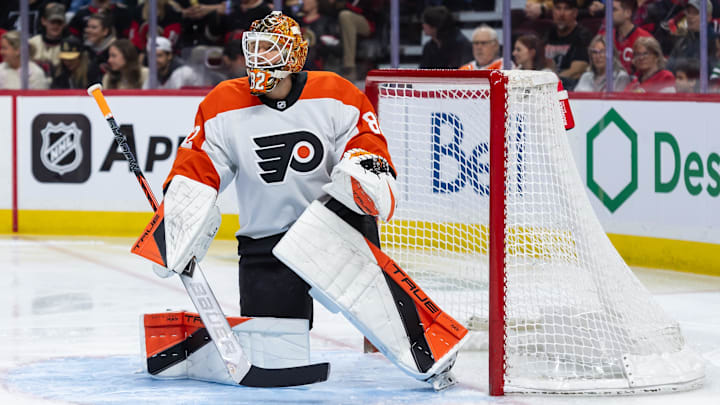How do you stop a perpetual motion machine that is the unending Flyers' goaltending carousel?
In nearly six decades, the Flyers have rarely been able to answer that question.
Discounting the tragedy of Pelle Lindberg and the recent goaltender we shall never discuss again, there has not been noteworthy homegrown talent.
Ron Hextall, the best goaltender ever drafted by the Flyers, led the team to the Stanley Cup Final as a rookie.
Bernie Parent may always be heralded as the most remarkable goalie in Flyers’ history. He came to Philly via the Bruins and spent a couple years with the Toronto Maple Leafs before the Stanley Cup championship seasons. In the East Division, he faced stiffer competition than the West, which was comprised of weaker expansion teams.
Roman Cechmanek was drafted by Philly but was 29 when he came. He played at the professional level for parts of eight seasons before coming to the NHL.
John Vanbiesbrouck, Steve Mason, Martin Biron, et al. came from other organizations.
We can go on in depth, but I think the point has been belabored by now.
So, how do you develop goalies within your system? The answers are incredibly simple and obvious. It is just a matter of doing it.
Scouting
It feels ridiculous to even say that, but it is the first step, and the Flyers have not had a ton of luck with goaltending prospects. Although it is hard to determine who scouted and recommended which goalies, there is one scout of note. Ken Hoodikoff is the European scout who discovered Sergei Bobrovsky. He scouted Matvei Michkov, although that was not a tough assignment.
Given that he is based in Russia, it is reasonable surmise that he played a hand in finding Ivan Fedotov, Alexei Kolosov, and Philly’s most exciting goalie prospect, Yegor Zavragin. Of the goalies since 2015, five are from Eastern Europe, and two of those have made it to the NHL. It remains to be seen if Zavragin will live up to the hype, but everything looks good so far.
But aren’t Fedotov and Kolosov busts?
Coaching
A scout can find raw talent, but it is up to the coaching to develop the players.
Fedotov and Kolosov haven’t looked NHL-ready yet, though their international careers showed promise. It is up to the coaches to help them transition to the North American game and hone their skills. There is a big key to doing that: Patience.
Patience
Sergei Bobrovsky was struggling a bit and worked with a team psychologist to help. However, the Flyers decided to move on from him way too early and his career took off after he parted ways with the team.
Kolosov also has some struggles both on and off the ice and it sounds like he and the Flyers will part ways, with Kolosov returning to Belarus. The organization was excited about bringing him to the U.S., but all that enthusiasm has dissipated from the team, the goalie, and the fanbase. This has the potential to echo parts of the Bobrovsky situation, though who knows if it will.
So, how do you stop letting these players fall through the cracks?
Retain draft capital
The Danny Briere tenure has yet to show many signs of having an itchy trigger finger, but the Flyers have a recent history of unnecessarily trading draft picks, sometimes to move on from players that were unnecessary to move, like Shayne Gostisbehere.
Goalies are hard to develop, and it takes a long time to get them to the NHL level. One way to counterbalance that is with volume. Goalies are not usually drafted in the first round, and teams have had success with drafting goalies in later rounds.
Picks from the fourth round on are not highly valued and can be easily thrown in with a trade as spare change to round things out. To paraphrase a Wayne Gretzky coach, you miss 100% of the goalies you don’t draft.
Numbers mean something at the NHL level too, though.
Depth & Tandems
The Boston Bruins have done a good job with goaltending depth and 1A/1B tandems. Tuukka Rask and Jaroslav Halak, Linus Ullmark and Jeremy Swayman, and Tim Thomas and Tuukka Rask are all examples of that.
The workload is more evenly split, which increases the endurance of the goalie and helps reduce the risk of injury. It also makes it difficult on other teams as they do not have an opportunity to face a weak backup.
The goaltending does not need to be elite to do this. It was a tandem of good backups that brought the Flyers to the Stanley Cup Finals in 2010. Michael Leighton and Brian Boucher could not have had the playoff run they did without the other. In the regular season, it was an unintentional trio with Ray Emery, who struggled with a torn abdominal muscle that eventually forced his season to an early end with surgery.
There’s no secret formula to developing goaltenders. It just takes smart scouting, good coaching, and a front office willing to be patient.
